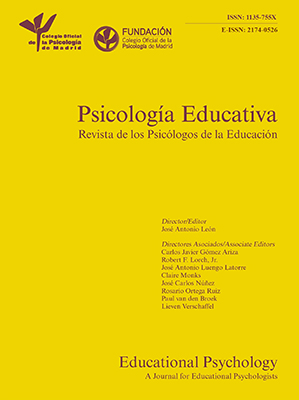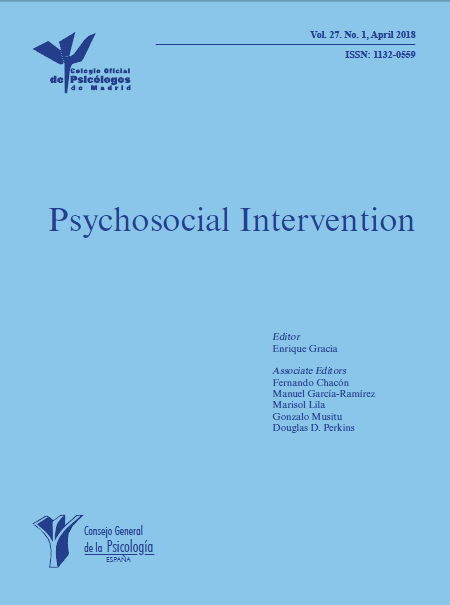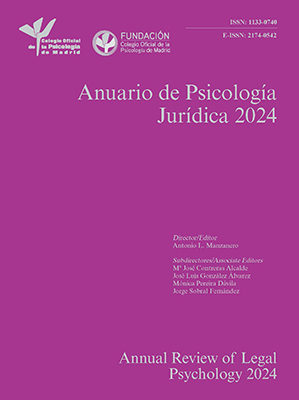
Differences in the Use of Strength-based Leadership among Spanish Armed Forces Commissioned Officers
[Las diferencias en el uso del liderazgo basado en la fuerza entre los oficiales de las Fuerzas Armadas españolas]
Fernando Díez1, Pedro C. Martínez-Morán2, José R. Sánchez Isla1, Elene Igoa Iraola1, and Elena Quevedo Torrientes1
1University of Deusto, Spain; 2Pontifical University of Comillas, Spain
https://doi.org/10.5093/jwop2025a1
Received 11 September 2024, Accepted 10 March 2025
Abstract
This study investigates how strength-based leadership functions within the Spanish Armed Forces. Strength-based leadership is a model that emphasizes leveraging personal strengths to enhance leadership capabilities and organizational performance. The research aims to explore the influence of strength-based leadership in relation to branch, rank, and gender among Commissioned Officers in the Spanish Armed Forces. The study was conducted using a sample of Commissioned Officers from the Army, Navy, Air and Space Force, and Joint Corps, differentiated by rank and gender. The Strengths Leadership Questionnaire was used to measure the following dimensions: Implementer, Innovator, Motivator, Analytical, and Mediator. The main conclusions of this research indicate that there is a greater, though not statistically significant, application of strength-based leadership among members of the Army. No appreciable differences were observed regarding rank or gender among military leaders. The results highlight the importance of developing a leadership model that considers individual strengths, with potential for extending its application to other Spanish military units.
Resumen
Este estudio examina el liderazgo basado en fortalezas dentro de las Fuerzas Armadas españolas, centrándose en su influencia según el cuerpo, empleo y género de los oficiales. El liderazgo basado en fortalezas aprovecha las capacidades personales para mejorar el liderazgo y el rendimiento organizacional. La investigación tomó una muestra de oficiales del Ejército de Tierra, la Armada, el Ejército del Aire y del Espacio y los Cuerpos Comunes, utilizando el Cuestionario de Liderazgo en Fortalezas para evaluar cinco dimensiones: Implementador, Innovador, Motivador, Analítico y Mediador. Los resultados muestran un uso ligeramente mayor, aunque no estadísticamente significativo, del liderazgo basado en fortalezas en el Ejército de Tierra, sin diferencias notables en cuanto a rango o género. El estudio destaca la importancia de un modelo de liderazgo que incorpore las fortalezas individuales y apunta a la posibilidad de ampliar su aplicación a otras unidades militares españolas.
Palabras clave
Liderazgo, Liderazgo basado en fortalezas, Fuerzas ArmadasKeywords
Leadership, Strengths-based leadership, Armed ForcesCite this article as: Díez, F., Martínez-Morán, P. C., Isla, J. R. S., Iraola, E. I., & Torrientes, E. Q. (2025). Differences in the Use of Strength-based Leadership among Spanish Armed Forces Commissioned Officers. Journal of Work and Organizational Psychology, 41(1), 1 - 9. https://doi.org/10.5093/jwop2025a1
Correspondence: fdiez@deusto.es (F. Díez).Leadership is a critical factor for the effective functioning of organizations. In the case of the Armed Forces, leadership is embedded in its culture. Doctrine, regulations, principles, and values define military leadership. Mission fulfillment is the axis around which a leader’s command revolves (Díez et al., 2023). There is no leadership without a mission, and there is no mission without effective command. Military leadership directly influences operational effectiveness, mission success, and organizational cohesion. The mandate and missions of the Spanish Armed Forces (hereafter, FAS) have evolved with societal changes and national needs. FAS are organized into the Army, the Navy, and the Air and Space Force. All are structured around Headquarters, Force, and Support Force. Additionally, there are four Joint Corps: Legal, Comptroller, Medical and Band Corps. Leadership involves getting team members to carry out the assigned tasks and activities. The resources they deploy relate to their capacities, skills, and knowledge. Leading through the strengths of team members fosters a positive spirit, focusing on excellent performance rather than areas of improvement. The greatest potential for development and growth in employees lies in their strengths (Buckingham & Clifton, 2001). Based on these premises, this leadership approach has the potential to maximize followers’ capabilities, optimize goal achievement, and promote high performance (Lee, 2015). The consequences are greater commitment (Wang et al., 2023), career advancements (Ding et al., 2023), increased efficiency and productivity (Burkus, 2011), and improved psychological well-being (Ding & Yu, 2022b), which enhances both the professional and personal development of subordinates and enlisted personnel. Strengths-based leadership (hereafter, SBL) is an approach that values both virtues and areas for improvement, aiming to optimize positive experiences for team members and ultimately improve organizational efficiency. This approach encourages leaders to deliberately enhance the strengths of their teams, creating an enriching and productive work environment. In the Spanish Armed Forces, leadership is traditionally structured around hierarchical command principles. Strengths-based Leadership (SBL) is not formally part of standard leadership training programs within the FAS, nor is it explicitly embedded in the military leadership doctrine. However, some elements of SBL, such as leveraging individual strengths and optimizing team capabilities, are inherently present in various command practices. This study aims to explore the extent to which SBL is recognized and applied within the FAS and whether it aligns with or deviates from existing military leadership models. This research explores the concept of SBL by using the Leadership Strengths Questionnaire (hereafter, LSQ) to evaluate and analyze these strengths among commissioned officers of the FAS. The LSQ is a comprehensive tool designed to measure leadership strengths across five global dimensions: implementer, innovator, motivator, analytical, and mediator. Each of these dimensions represents essential qualities that contribute to effective leadership. The aim of this research is to analyze the degree to which SBL is applied in the military sphere and to assess how significantly it can improve overall performance in a dynamic, challenging, and high-risk environment, such as the military context in which leadership is exercised. The research hypotheses explore whether belonging to a specific branch of the military, the rank, and the gender may influence the use of strengths as a leadership approach in the military. Each branch operates within distinct organizational frameworks and faces unique operational challenges that may shape the development and expression of specific leadership strengths. The hierarchical structure of military organizations suggests that leadership strengths may also vary depending on the different levels of responsibility, decision-making authority, and job demands. In Spain, Royal Decree-Law 1/1988, February 22 (BOE 46, 1988), regulated women’s access to the Armed Forces, marking a turning point in military leadership, which had been exclusively male until then. This research on SBL using the LSQ in a military context aims to provide a detailed understanding of how this type of leadership is exercised in the FAS. By examining differences based on branch, rank, and gender, the study seeks to uncover valuable insights that may inform leadership application, enhance operational performance, and contribute to leadership research by analyzing how SBL operates within the military context. This study contributes to the broader field of leadership studies by providing empirical data on the relationship between SBL, organizational context, hierarchical structure, and the influence of gender. The findings of this study may be applicable beyond the military, offering valuable lessons for similar environments. This paper is divided into four sections. The first section analyzes the foundations of SBL and its application to military leadership. The next section presents the research methodology, as well as the results obtained and their analysis. The third section delves into the influence of branch, rank, and gender on the application of SBL. Finally, the last section summarizes the main conclusions of the research and discusses its implications to support future studies. Theoretical Background Leadership Dynamics, Organizational Needs, and Employee Development Leadership is one of the central axes of organisations, a factor that shapes enterprises’ identity (Uhl-Bien & Arena, 2018). This factor influences the culture of the organization, the work dynamics between employees, and the communication between different departments (Jiang & Men, 2017). It is an element that, though intangible, influences all organizational levels (Koohang et al., 2017). Every company has its own vision and mission, which would reflect the product or service that the company provides and the values of the company (Dermol & Širca, 2018). In this way, leadership styles would vary on the enterprises work philosophy and objectives (Taiwo & Lawal, 2016). Thus, leadership reflects the values of an organisation and the work culture (Ali et al., 2015). When talking about leadership, it necessary to highlight the importance of the role of the leader in team works, departments, and the entity (Oreg & Berson, 2019). The leader’s characteristics usually differ on the particularity of the sector, company’s values, and organizational goals (Karaszewski & Drewniak, 2021). Thus, organisations must pay close attention to their purpose and choose the right leader to get all the employees committed to the organization’s global objectives (Limsila & Ogunlana, 2008). Thus, leaders have great responsibility on leading and transferring organisations values to reach out short and long-term goals (Kotter, 1990). Leadership influences many external organisational factors, such as efficiency (Malik, et al., 2021), productivity (Almatrooshi, 2016), competitive advantage (Anning-Dorson, 2018), or business performance (Saha et al., 2020), but also influences internal factors, such as employee’s performance (Setiawan et al., 2021), or well-being (Inceoglu et al., 2018). Different studies have shown that leadership characteristics and leader’s performance can influence employees’ self-esteem (Kim & Beehr, 2018; Walsh & Arnold, 2020). These are some of the reasons why organisations invest in discovering which are their values, mission, and vision, and therefore apply a leadership style that matches their identity (Subramony et al., 2018). In addition, companies’ workforces are experiencing changes, as more than four generations are coexisting in the work department, and the perspective towards work and the organisation differ (Stewart et al., 2017). It is the leader’s job to analyse, understand, and attend to the needs of each employee to give their maximum potential to carry out their work and reach the goals set by the organisation (Wu & Parker, 2017). Thus, a good leader can see specific skills of each employee and encourage them to take advantage of it to achieve organizational goals (Newstead et al., 2021). In other words, a good leader brings out the best in each employee to solve the different problems that may arise when closing a project, obtaining results, completing a mission, or performing a specific task (Jit et al., 2017). Strengths-based Leadership The leadership style that sets the person at the centre and focuses on the skills of individuals to achieve organizational goals is called strengths-based leadership (Ding & Yu, 2022a). This leadership style comes from Positive Psychology and is characterized by a humanistic approach where the leader values the best aspects of everyone to enhance them and obtain the best results (Ding & Yu, 2020b). This approach considers that each employee has a specific skill that needs to be exploited. Thus, it focuses on individuals’ specific characteristics and skills to perform a particular task (Rath & Conchie 2008). Strengths-based leadership focuses on enhancing all positive aspects of everyone, thus obtaining a heterogeneous work group where all participants have their expertise and task assigned, where the leader trusts each participant’s abilities (Van Woerkom et al., 2016). Organisations are embracing strengths-based leadership because it empowers individuals and brings out the best of them when performing a task or creating a product (Ding et al., 2024). Strengths-based leadership improves efficiency and effectiveness of teams and organisations and contributes to the individual employee’s well-being (Burkus, 2011). When employees feel valued and consider that their work has an impact, both internally and externally, on the organisation, they feel more fulfilled with their work and more attached with the organization (Van Woerkom & Meyers, 2015). This impacts directly on individuals’ well-being and makes them feel more comfortable in the organisation as they consider themselves to be a fundamental part of an entity (Robertson & Cooper, 2010). Along these lines, applying strengths-based leadership on organizations, employees’ traits are valued while they contribute to the fulfilment of the objectives of the work team or organisation (Ding et al., 2020b). When applying strengths-based leadership it is necessary that leaders and subordinates have a good knowledge of their own abilities, skills, and weaknesses (Linley et al., 2007). This facilitates the identification of everyone’s strengths, and thus the distribution of tasks within the group (Wang & Ding, 2023). The leader must be able to identify which task is best suited to each subordinate so that they can exploit their best skills and enjoy the tasks that are carrying out (Drønnen, 2022). Working on employees’ skills and having knowledge of it facilitates communication between subordinates and leaders (Warren, 2017). Thus, keeping track of the skills of each subordinate and their interests is necessary to keep them motivated with the work and the organization (Aguinis et al., 2012). There might be employees who would like to develop other skills to carry out their work - in these cases leaders need to detect these motivations to give them the resources to do so (Liu & Tong, 2022). Thus, it is important to channel these personal interests so that employees continue learning and improving their skills (Ding et al., 2023). The goal of strengths-based leadership is to give space to the individual to develop their skills and contribute to the company within it (Ding & Yu, 2020b). Strengths-based leadership highlights among leadership styles because it emphasizes recognizing and leveraging individual strenghts to enhance employee engagement, resilience, and job satisfaction. Unlike transformational leadership, which focuses on inspiring change and articulating a vision, or servant leadership, which prioritizes meeting employees’ needs (Schermuly et al., 2022), strengths-based leadership focused on developing the existing capabilities of employees. On the other hand, transactional and transformational leadership styles have been connected to organizational innovation by influencing the organizational climate and behaviors (Alblooshi et al., 2022). While strengths-based leadership does not explicitly aim at promoting innovation, it can encourage innovative behavior by fostering a growth mindset and motivating the use of individual strengths (Liu & Tong, 2022). Relational leadership styles, which emphasize building strong interpersonal relationships, have been shown to lead to higher job satisfaction compared to task-focused leadership styles that prioritize completing tasks (Cummings et al., 2018). Strengths-based leadership aligns more closely with relational leadership, as it emphasizes personal development and the use of individual strengths rather than merely focusing on task completion. Furthermore, by addresing fundamental needs such as trust, stability, and hope, strengths-based leadership can reduce turnover intentions and enhance overall team performance. This sets it apart from more transactional or autocratic leadership approaches (Chu et al., 2022). Although transformational and servant leadership styles also aim to empower employees, they do so through different means. In contrast, transactional leadership is generally less effective in fostering empowerment. Strengths-based Leadership in the Military Strengths-based leadership is used in different sectors, and one of them is the military (Key-Roberts, 2014). This leadership style is of great interest in this sector, since teamwork is one of the core elements in the day-to-day execution (Chérif et al., 2021). This specific sector is characterised by being able to react quickly and efficiently (Gayton & Kehoe, 2019). Employees in the military face life-threatening situations (Gayton & Kehoe, 2019). Thus, mutual support and trust in each other are essential factors for accurate work performance (Stanton, 2011). Thus, strengths-based leadership promotes trust and a good work atmosphere as all participants are embraced to perform their skills to carry out their tasks (Ding & Yu, 2022a). Strengths-based leadership reinforces the relationship between colleagues; therefore, the group results overall are more optimal (Ding & Yu, 2022b). The fact that each participant works on the improvement of their own skills makes all members of the team feel part of the group with a specific role (Ding & Quan, 2021). This increases the commitment of the to the group to the organizations general and specific objectives (Ding & Yu, 2022b). This research focuses on analyzing how commissioned officers in the FAS apply SBL. It represents a step forward in understanding this leadership style. The scientific contribution of this research lies in evaluating the level of SBL within the Spanish military. This research is a step forward on the understanding of strengths-based leadership. In this way, the scientific contribution of this research stands on the analysis of the level of the strengths-based leadership on the Spanish Armed Forces. This study will help the staff to make a better analysis of the current situation of strengths-based leadership and its application to the military. Research Design This study is part of the research project LIES 2023-0000152 Leadership and Strategy, funded by the Spanish Ministry of Defense. The research uses a mixed-methods approach, involving the collection, analysis, and integration of both quantitative and qualitative data. This methodology is suitable for the research problem and the stated objective. The research design was completed in September 2023, with data collection and analysis concluding in October 2023. An ad hoc questionnaire was developed using the QUALTRICS platform and was organized into four sections: the first section gathered descriptive information about the sample, the second section featured the LSQ questionnaire (Northouse, 2020, the third section included open-ended questions on leadership and strengths, and the fourth section focused on identifying key aspects of leadership. Figure 1 Rank of the Commissioned Officer Who Responded to the Survey.. The figure shows the number the Spanish commisioned officers who responded to the survey.  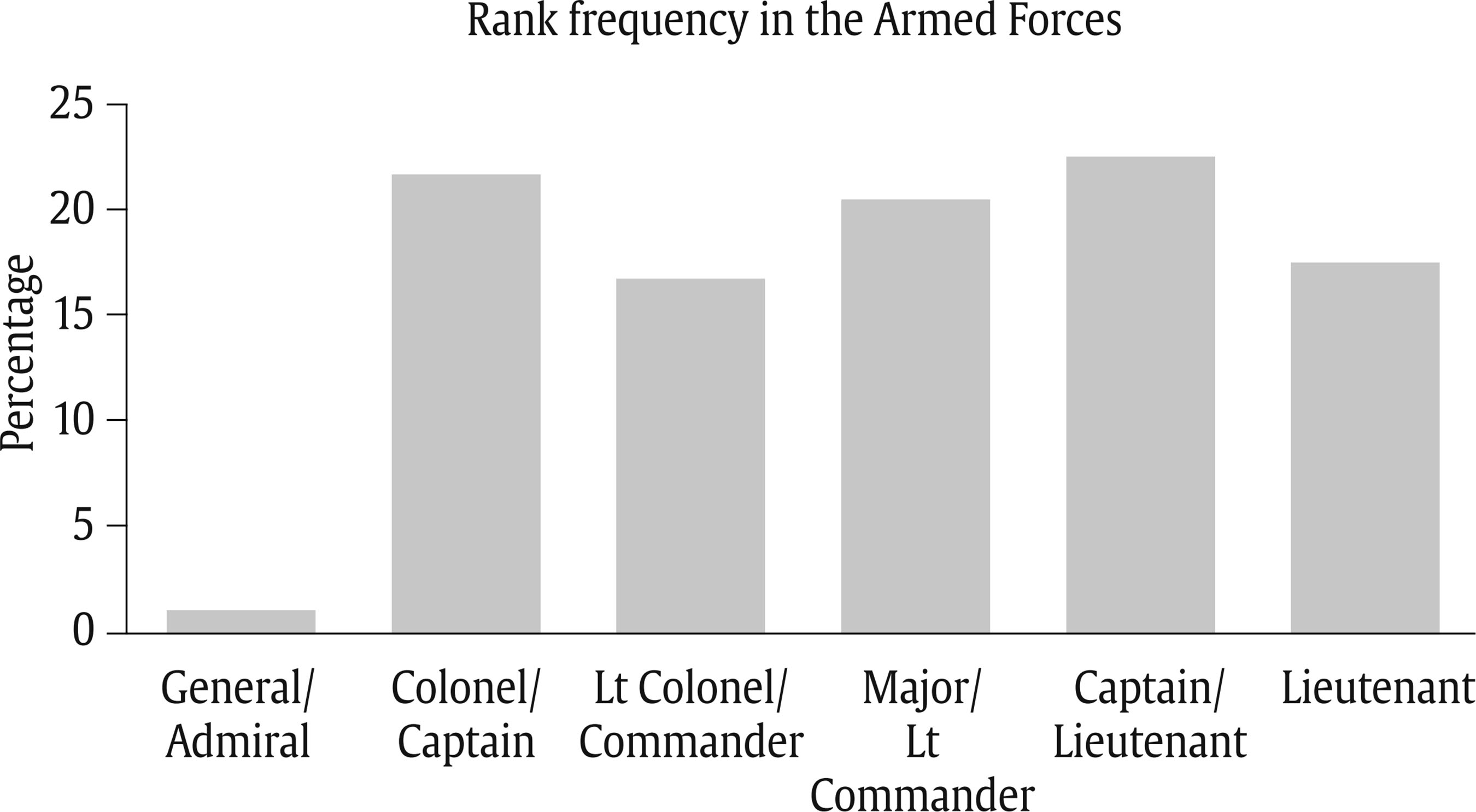 The Ministry of Defense handed out the questionnaire across the Spanish military branches, starting in September 2023 and concluding by mid-October 2023. The study was conducted with an informed consent, and received ethical approval from the University of Deusto, under report number ETK-4/23-24. Participants The study sample consists of 102 Commissioned Officers from the, Navy, Air and Space Force, and Joint Corps. Of these, 92 are men (90.19%) and 10 are women (9.8%). All participants are currently on duty. The ages of the participants range from 24 to 63 years, with an average age of 44.96 years (SD = 11.09). Regarding rank within the FAS (Figure 1), the Commissioned Officers are distributed as follows: 18 Lieutenants, 23 Captains/Lieutenants, 21 Majors/LtCommanders, 17 Lt Colonels/Commanders, 22 Colonels/Captains, and one General or Admiral. The project has informed consent from the participants and a favorable ethics report from the University of Deusto, ETK-4/23-24. Questionnaire The LSQ measures five leadership dimensions: (1) Implementer, focused on executing tasks effectively; (2) Innovator, associated with creativity and problem-solving; (3) Motivator, linked to inspiring and energizing others; (4) Analytical, related to structured decision-making; and (5) Mediator, assessing the ability to manage conflicts. Responses were collected using a seven-point Likert scale ranging from 1 (never) to 7 (always). This questionnaire consists of 30 items and helps participants understand their leadership strengths, categorizing them into the five performance areas mentioned. It is designed to assess strengths in the areas of implementation, innovation, stimulation, analysis, and mediation (Northouse, 2020). By evaluating their scores, participants can identify their strongest areas as well as those where they may be weaker. Aims The aim of this research is to address the following questions:
SBL was evaluated using the Leadership Strengths Questionnaire (Northouse, 2020). The participants’ overall average score was 119.20 points (SD = 11.60), with a minimum score of 74 and a maximum score of 145. The 25th percentile was 112.25, the 50th percentile was 120, and the 75th percentile was 127.37 points. Table 1 provides the average scores for each dimension. The normality of the sample was analyzed using the Kolmogorov-Smirnov test with Lilliefors significance correction (0.52, df = 108, p = .20), and homoscedasticity was assessed through Levene’s test for equality of variances (F = 1.951, p = .165), allowing for the use of parametric tests for group comparisons. The overall test scores differ slightly between men (M = 119.41, SD = 11.92) and women (M = 117.2, SD = 8.1), but the difference does not reach statistical significance. An independent samples t-test was conducted to compare overall scores between sexes. The calculated t-statistic was 0.571 (df = 106, p > .05). Differences by Gender Absolute differences between genders have been observed (Table 2), but these differences do not reach statistical significance. In the Implementer dimension, the Student’s t-test yields a value of -0.53 (df = 106, p=0.60); in Innovator, t = 0.90 (df = .106, p = .37); in Encourager, t = -0.29 (df = 106, p = .78); in Analytical, t = 1.49 (df = 106, p = .14); and in Mediator, t = 0.80 (df = 106, p = .42). The global average scores on the LSQ have been determined for each branch and each dimension (Table 3). In terms of overall scores, no substantial differences are observed between the branches. The average scores are as follows: 4.10 (SD = 0.50) for the Army, 4.00 (SD = 0.39) for the Navy, 3.95 (SD = 0.37) for the Air and Space Force, and 3.93 (SD = 0.57) for the Joint Corps. The difference in dimension scores between the different branches has been analyzed, excluding the Joint Corps from the calculations because their low number of responses (3) could compromise the test results. For this purpose, a one-way ANOVA was used, taking each dimension as the dependent variable and the branch belonging to as the independent variable. Differences between branches were found only in the Innovator dimension (see Table 4). Levene’s test allows us to assume the equality of variances between the groups (F = 0.005, p = .995). It is concluded from Table 4 that there is a significant difference (p < .05) between the groups for the Innovator dimension. The post hoc tests (Table 5) were conducted using Tukey’s test, revealing a significant difference between the scores of the Army and the Air and Space Force, as well as a near-significant difference in relation to the Navy in the Innovator dimension. The scores are higher in the former compared to the latter. The global average scores on the LSQ have been analyzed by rank and by dimension (Table 6). No differences were observed based on Commissioned Officers' rank or the branches to which they belonged. No substantial differences were found according to the rank. For General/Admiral, the average score is 4.08; for Colonel/Captain, the average is 3.92 (SD = 0.56); for Lt Colonel/Commander, the average is 3.97 (SD = 0.30); for Major/Lt Commander, the average is 3.99 (SD = 0.33); for Captain/Lieutenant, the average is 4.01 (SD = 0.37); and Lieutenant, the average is 4.01 (SD = 0.37). There are no significant differences in LSQ scores based on gender or rank. However, significant differences are obtained by branches, specifically in the Innovator dimension, with the Army showing notable differences compared to the other branches. The findings of this study provide insights into the application of Strength-based Leadership (SBL) within the Spanish Armed Forces. The results suggest that while SBL is not formally integrated into the military leadership doctrine, some of its principles are inherently practiced. The higher scores in the Innovator dimension among Army officers suggest that the nature of their roles may demand greater adaptability and creative problem-solving, aligning with previous research on leadership adaptability in high-stakes environments (Ding & Yu, 2022b). Interestingly, no significant differences were found in overall SBL scores based on rank or gender. This contrasts with studies in civilian organizations where leadership styles often vary significantly between hierarchical levels (Kim & Beehr, 2018). A possible explanation is the highly standardized leadership training within the military, which may reduce variability in leadership approaches across ranks. The slight variation in gender-based scores, where women scored higher in Implementer and lower in Analytical dimensions, warrants further exploration in future research, as it may suggest differences in leadership development opportunities or self-perception biases (Van Woerkom & Meyers, 2015). From a practical perspective, the findings suggest that while SBL aligns well with military leadership needs, there is room to enhance certain dimensions, such as Mediation and Encouragement, which received lower scores. Targeted training programs focusing on these aspects could strengthen overall leadership effectiveness and team cohesion, especially in high-pressure military settings. Additionally, the differences observed between branches highlight the need to adapt leadership development programs to the specific operational demands of each force. Theoretically, this study contributes to the growing literature on SBL by providing empirical data from a military context, which has been relatively understudied compared to corporate environments. Future research should further explore the long-term impact of SBL training in military organizations and how it influences mission success and operational performance. The SBL approach values the virtues and areas for improvement to optimize performance and enhance organizational efficiency. This leadership style is used in the Armed Forces (Key-Roberts, 2014), which are characterized by their ability to respond quickly and effectively to life-threatening situations (Gayton & Kehoe, 2019), distinguishing them from other types of activities. The aim of this research was to analyze the extent of SBL application by Commissioned Officers of the FAS. The LSQ measures five dimensions: Implementer, Innovator, Encourager, Analytical, and Mediator. Each of these dimensions represents essential qualities that contribute to effective leadership. The research hypotheses sought to verify whether affiliation with the Army, Navy, Air and Space Force or Joint Corps, rank, and gender influence the use of LSQ dimensions. The analysis aimed to determine if unique missions and operational challenges, varying levels of responsibility, or gender differences affect the use of SBL dimensions. The results show a uniform distribution of scores across the five LSQ dimensions, with minor variations between branches. The Analytical dimension received the highest average score, suggesting a strong tendency towards analysis and problem-solving in military leadership. Conversely, the encourager and mediator dimensions had the lowest average scores, indicating potential areas for development in mediation and conflict resolution skills. SBL is founded on promoting trust and a positive work environment, as all participants are motivated to utilize their skills and perform their tasks effectively (Ding & Yu, 2022b). Additionally, focusing on improving one’s skills encourages all team members to feel part of the same unit (Ding & Quan, 2021). Significant differences were observed in the innovator dimension between military branches. Army Commissioned Officers scored significantly higher in this dimension compared to other branches, which may reflect a greater need for innovation and adaptability in their operational context. This finding suggests that the specific demands of each branch can influence the development and application of different leadership strengths. Although no significant differences were found in overall LSQ scores between men and women, women tended to score slightly higher in the Implementer dimension and lower in the Analytical dimension. This suggests that, while differences are not statistically significant, there may be variations in perceived and exercised leadership strengths by gender that warrant further investigation. These findings may have practical implications for the implementation of SBL in FAS. On the one hand, the results highlight the importance of training and development programs that specifically address less prevalent leadership dimensions, such as encouraging and mediation. Strengthening these areas could enhance team cohesion and effectiveness, especially in high-stress and high-risk situations. On the other hand, the absence of significant gender differences suggests that current diversity and inclusion policies may be functioning effectively. However, it remains important to continue fostering an environment that allows all genders to develop and apply their leadership strengths effectively. Finally, differences in the Innovator dimension scores among branches suggest the need to tailor leadership programs to the specific needs of each branch. This could include customized approaches that encourage innovation in branches facing unique challenges. Conclusion This study examined the application of Strength-based Leadership (SBL) among Spanish Armed Forces Commissioned Officers, analyzing differences by branch, rank, and gender. The findings reveal that while SBL is not explicitly incorporated into military leadership training, its principles are naturally embedded in various command practices. The Army exhibited higher scores in the Innovator dimension, likely due to the dynamic nature of its operations requiring adaptability and creativity. No statistically significant differences were observed in SBL scores based on rank or gender, suggesting that military leadership training may standardize leadership approaches across hierarchical levels. However, slight variations in leadership dimensions by gender indicate areas for further exploration. The results highlight the potential benefits of incorporating formal SBL training into military leadership programs. Specifically, targeted development in mediation and encouragement skills could enhance overall leadership effectiveness. Future research should focus on the impact of SBL in specific operational contexts and its influence on team performance and mission outcomes. By advancing understanding of SBL in the military, this study provides a foundation for future investigations and offers practical recommendations for leadership development within the Armed Forces. Leadership is structured and applied in the Armed Forces as a distinctive element of its mission. The military environment, therefore, becomes a productive ground for utilizing and applying the most powerful and fruitful skills of military leaders. The FAS, with its long tradition and history, has its own doctrine and leadership model. However, the Navy, the Army, and the Air and Space Force each have their own doctrinal structure. SBL does not undermine doctrines or models. It is a leadership approach that builds on the strengths of team members, focusing on the traits that make them stand out, which are beneficial for both the individual and the group. While traditional models have often focused on identifying and correcting weaknesses, this model proposes recognizing and leveraging individuals’ and teams’ positive qualities and inherent capacities. SBL envisions that the relationship between leaders and subordinates fosters stronger development spaces compared to other existing models. Subordinates will feel more valued, and the leader gains coherence. SBL offers a promising framework to optimize performance and well-being in the FAS. The findings of this study highlight the importance of recognizing and developing individual strengths within a military context, adapting to the specific demands of each branch - Army, Navy, Air and Space Force, and the Joint Corps - and promoting inclusive and effective leadership. Future research could benefit from a more balanced and extensive sample across the Army, Navy, the Air and Space Force, and the Joint Corps. It would also be valuable to explore differences in leadership strengths in specific operational contexts and their impact on performance and mission effectiveness. This could further contribute to the professional and personal development of FAS commissioned officers. Limitations of the Research This study presents some limitations that should be considered when interpreting the results. First, the representativeness of the sample was affected by limited participation from the Joint Corps, suggesting that a larger sample from this group could have provided a more comprehensive view of leadership in the FAS. Additionally, the number of Commissioned Officers who responded to the questionnaire is not proportional to the number of Commissioned Officers in each branch, which may have biased the results toward certain leadership perspectives or experiences. One aspect to consider is the potential self-report bias, as evidenced by generally high scores across all dimensions (around 4 out of 5) and high overall totals (a mean of 119.20 out of 150). This trend, along with the observed score range (74 to 145), suggests a tendency towards positive self-evaluation or a social desirability bias, which may not accurately reflect the real diversity of leadership styles within the FAS. Although the study did not find significant differences between men and women in leadership, it did not delve into the underlying reasons or implications of this finding. The lack of significant differences could be due to the sample size or other unconsidered factors, pointing to the need for more in-depth research on this issue. It is important to note that the study focuses exclusively on the military context, limiting the generalizability of the results to other leadership environments. The unique characteristics of the military setting and the way they may influence the observed leadership styles were not explored in depth, representing a potential area for future research. Finally, the study did not thoroughly examine contextual factors that may influence leadership styles, such as specific training received, experience in international missions, or recent organizational changes within the FAS. Considering these factors, future studies could provide a more holistic understanding of military leadership. These limitations, far from diminishing the value of the study, present opportunities for future research that could address these aspects and offer a deeper, more nuanced understanding of leadership in the FAS. Conflict of Interest The authors of this article declare no conflict of interest. Acknowledgement We appreciate the support of the Spanish Ministry of Defense in the development of this research. References |
Cite this article as: Díez, F., Martínez-Morán, P. C., Isla, J. R. S., Iraola, E. I., & Torrientes, E. Q. (2025). Differences in the Use of Strength-based Leadership among Spanish Armed Forces Commissioned Officers. Journal of Work and Organizational Psychology, 41(1), 1 - 9. https://doi.org/10.5093/jwop2025a1
Correspondence: fdiez@deusto.es (F. Díez).Copyright © 2025. Colegio Oficial de la Psicología de Madrid



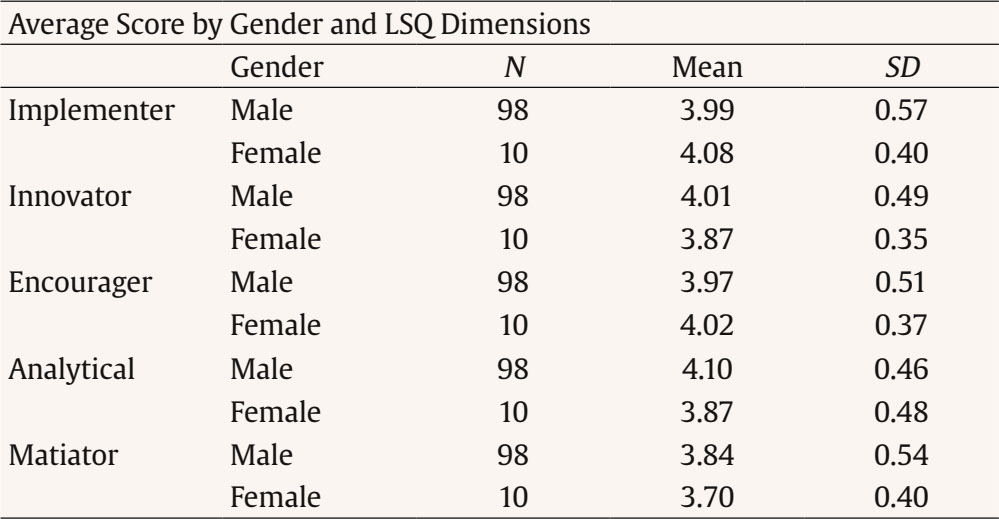
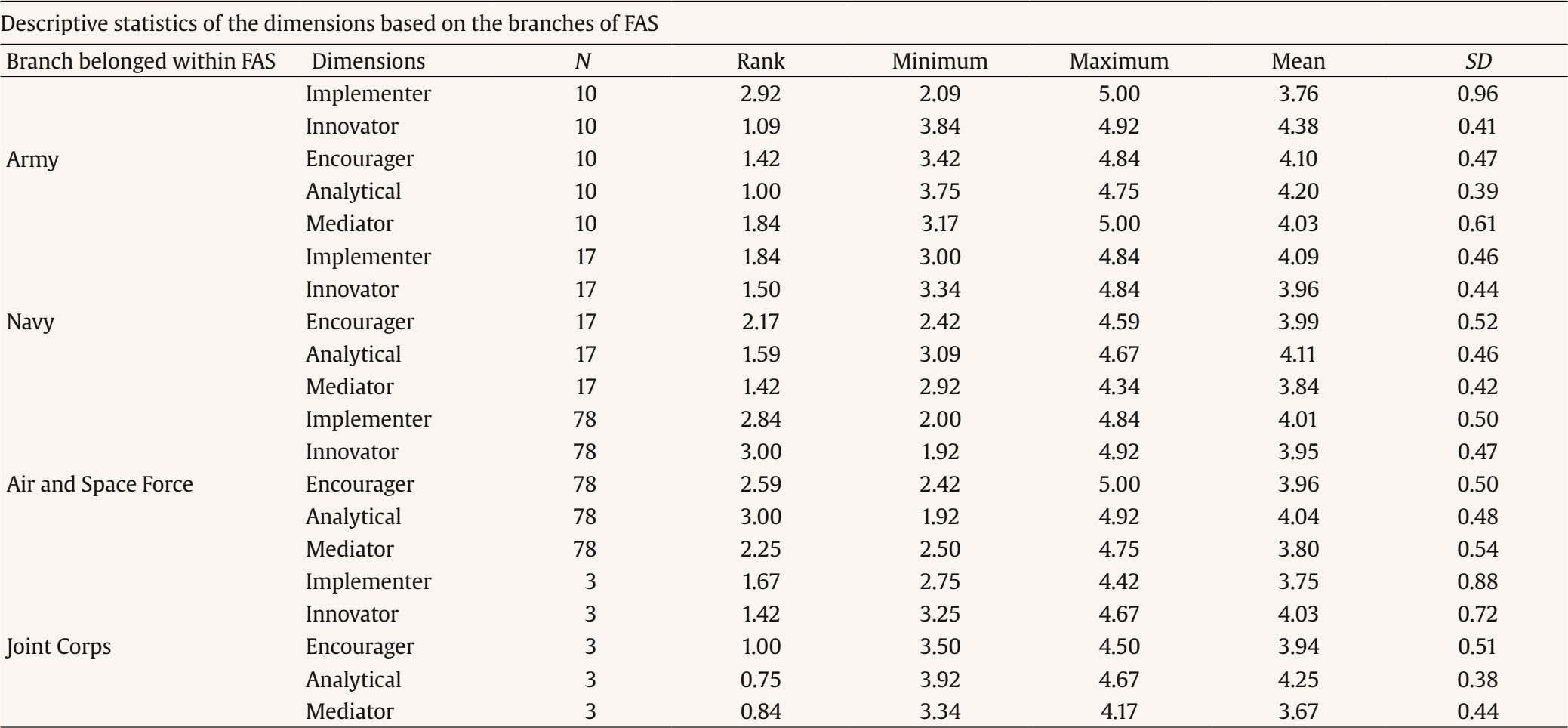


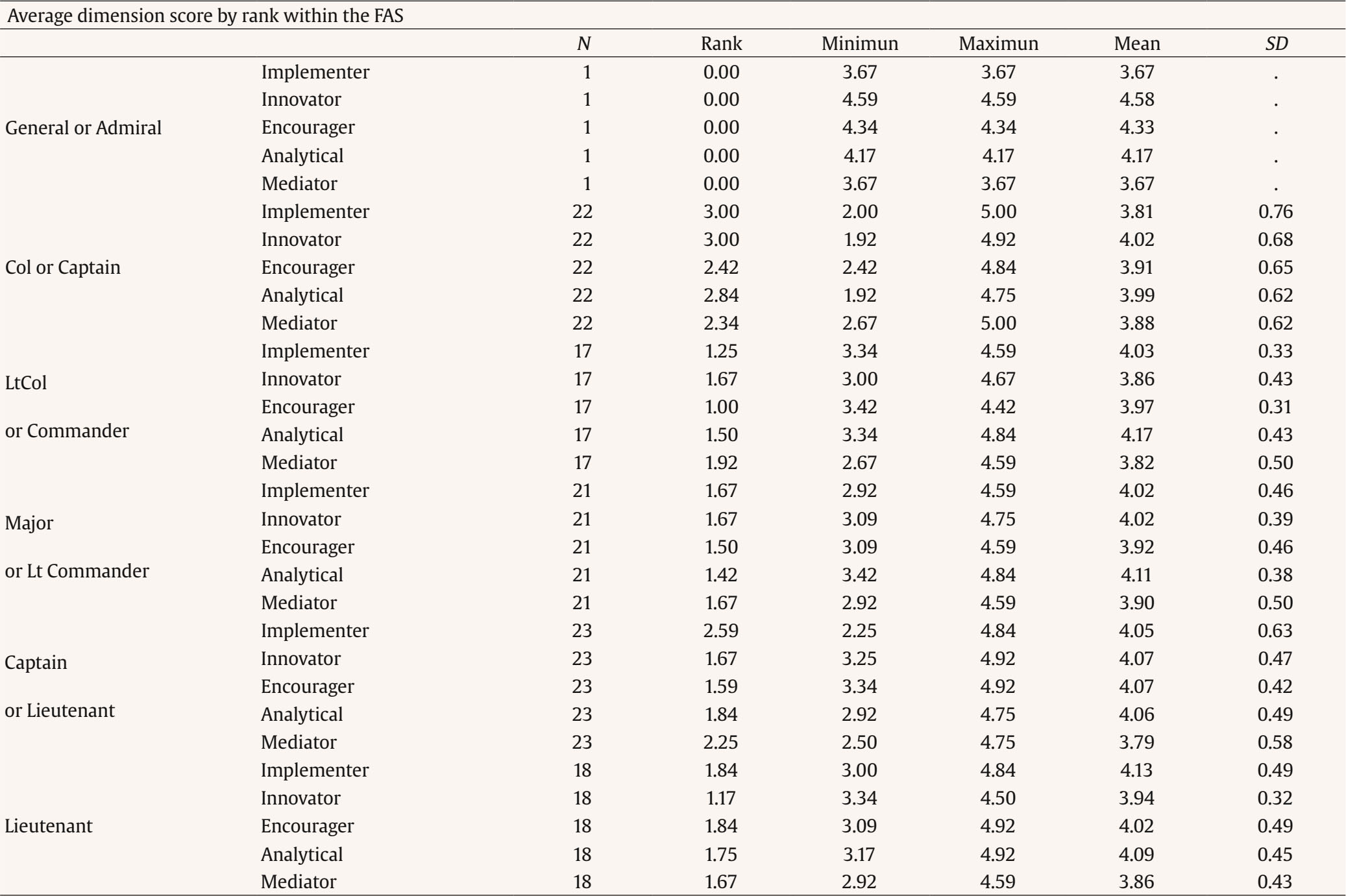






 e-PUB
e-PUB CrossRef
CrossRef JATS
JATS
